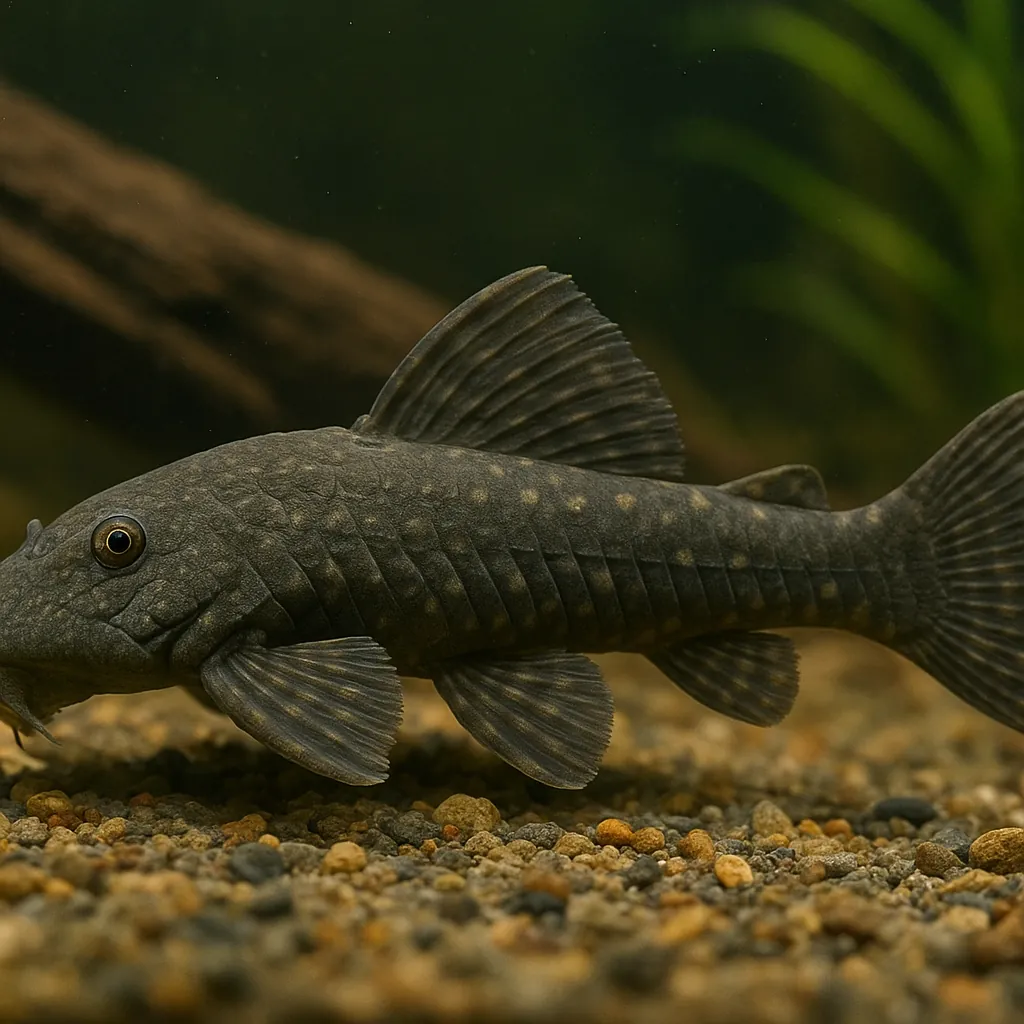
Rubber pleco
Introduction
The Rubber Lip Pleco, also known as the Rubbernose Pleco, is a popular freshwater fish among aquarists for its algae-eating abilities and peaceful demeanor. Native to South America, this species is well-suited for community tanks and is relatively easy to care for, making it an excellent choice for both novice and experienced fishkeepers. With proper care, Rubber Lip Plecos can live up to 12 years, providing long-term enjoyment for their owners.
What makes the Rubber Lip Pleco a good choice for beginners?
Their hardy nature and adaptability to various water conditions make them forgiving for those new to fishkeeping.
How large do Rubber Lip Plecos grow?
They typically reach a size of 5 to 7 inches (13 to 18 cm) in length.
Do Rubber Lip Plecos require special care?
While they are relatively low-maintenance, providing a suitable environment and diet is essential for their well-being.
Care and Environment
Proper care for Rubber Lip Plecos involves creating an environment that mimics their natural habitat. A minimum tank size of 95 liters is recommended to provide ample space for movement and growth. Maintaining water temperatures between 22°C and 27°C, with a pH range of 6.5 to 8, is ideal. Water hardness should be kept between 6 and 14 dGH.
Effective filtration is crucial to maintain high water quality, as Rubber Lip Plecos prefer well-oxygenated water. A strong filter, such as a canister filter, is suitable for this purpose. Lighting should be kept low to moderate, aligning with their nocturnal nature.
In terms of diet, Rubber Lip Plecos are primarily herbivorous, feeding on algae and biofilm. Supplementing their diet with vegetables like zucchini, cucumber, spinach, and lettuce is beneficial. Algae wafers and sinking pellets can also provide necessary nutrients. Occasional protein supplements, such as blanched peas or brine shrimp, can be offered.
The tank should include a soft sand substrate to protect their delicate barbels. Adding driftwood, caves, and rocks provides hiding spots and mimics their natural environment. Live plants like Java Ferns, Anubias, and Amazon Swords can enhance the tank's aesthetics and offer additional hiding places.
How often should I feed my Rubber Lip Pleco?
Feeding once or twice daily is sufficient, ensuring a balanced diet with both plant-based foods and occasional protein.
Can Rubber Lip Plecos survive solely on algae in the tank?
While they consume algae, it's important to supplement their diet with vegetables and commercial foods to meet their nutritional needs.
Do they require a specific type of lighting?
Low to moderate lighting is preferred, as they are nocturnal and thrive in subdued light conditions.
Origin and Habitat
Rubber Lip Plecos are native to the fast-flowing rivers and streams of the Andean region in South America, particularly Colombia and Venezuela. They inhabit areas with strong currents and rocky substrates, thriving in clean, oxygen-rich waters with temperatures ranging from 22°C to 29°C and a pH level of 6.5 to 7.5.
What type of environment do Rubber Lip Plecos prefer?
They favor fast-flowing, oxygen-rich rivers with rocky substrates and abundant vegetation.
Are they found in still or slow-moving waters?
No, they are typically found in fast-flowing rivers and streams.
Do they experience seasonal changes in their natural habitat?
Yes, their native regions often have intense rainy seasons, leading to significant variations in water levels and temperatures.
Temperament and Compatibility
Rubber Lip Plecos are known for their peaceful temperament, making them suitable for community tanks. They are non-aggressive and can coexist with a variety of tank mates, including tetras, Corydoras catfish, and gouramis. However, they may become territorial with other plecos, especially in smaller tanks.
It's advisable to avoid housing them with large, aggressive fish like Oscars or certain cichlids, as these species can harass or harm the pleco. Providing ample hiding spots and ensuring sufficient space can help minimize potential territorial disputes.
Are Rubber Lip Plecos suitable for community tanks?
Yes, their peaceful nature makes them excellent candidates for community aquariums.
Can I keep multiple Rubber Lip Plecos together?
It's possible, but they may become territorial with each other, especially in smaller tanks.
What are some ideal tank mates for Rubber Lip Plecos?
Suitable companions include tetras, Corydoras catfish, and gouramis.
Interesting Facts
Rubber Lip Plecos are nocturnal, meaning they are most active during the night. They have a unique ability to adhere to various surfaces using their specialized mouth, allowing them to graze on algae in hard-to-reach areas. Despite their algae-eating habits, they do not harm live plants, making them beneficial for planted aquariums.
Do Rubber Lip Plecos require a specific diet?
While they primarily consume algae, supplementing their diet with vegetables and commercial foods ensures they receive all necessary nutrients.
Are they easy to breed in captivity?
Breeding Rubber Lip Plecos in home aquariums is challenging and rarely successful.
How do they contribute to the aquarium environment?
By consuming algae, they help maintain a clean tank and reduce maintenance efforts for aquarists.
Sources
All information in this article has been gathered from the following reputable sources:
Overview
Recommended Tank Size 74.8 Gallons (for fully grown individuals) |
Minimum Group Size 1 |
Minimum Tank Volume 25.1 Gallons |
Maximum Adult Length 7.1 inches |
Average Adult Length 5.9 inches |
Shoaling (6+ required) No |
Preferred Water Type Freshwater, soft to moderately hard, slightly acidic to neutral |
Temperature Range (°C) 22–27 |
pH Range 6.5–8 |
Water Hardness (dGH) 6–14 |
Typical Lifespan (years) 10 years |